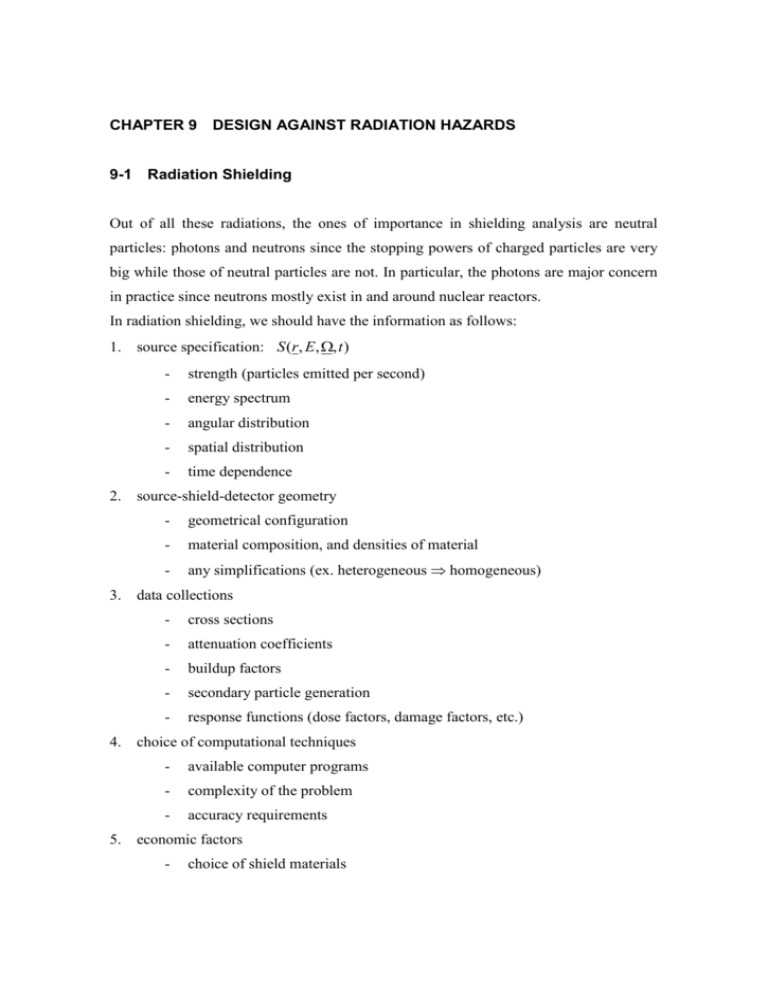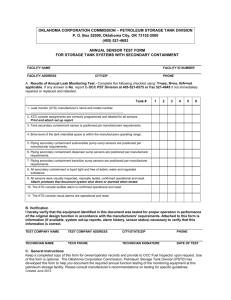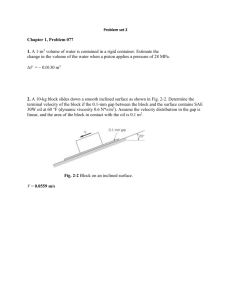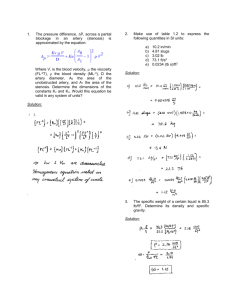health physics - Nuclear for Peace Purpose
advertisement

CHAPTER 9 9-1 DESIGN AGAINST RADIATION HAZARDS Radiation Shielding Out of all these radiations, the ones of importance in shielding analysis are neutral particles: photons and neutrons since the stopping powers of charged particles are very big while those of neutral particles are not. In particular, the photons are major concern in practice since neutrons mostly exist in and around nuclear reactors. In radiation shielding, we should have the information as follows: 1. source specification: S (r, E, , t ) - strength (particles emitted per second) - energy spectrum - angular distribution - spatial distribution - time dependence 2. source-shield-detector geometry - geometrical configuration - material composition, and densities of material - any simplifications (ex. heterogeneous homogeneous) 3. data collections - cross sections - attenuation coefficients - buildup factors - secondary particle generation - response functions (dose factors, damage factors, etc.) 4. choice of computational techniques - available computer programs - complexity of the problem - accuracy requirements 5. economic factors - choice of shield materials - safe vs. penalty - fixed vs. mobile shields - advantages of using existing structural materials 6. measures - verification by actual measurements - compare with other data 7. others - requirement of thermal insulation - erection methods - inspection and test procedures - streaming through penetrations (labyrinths, etc.) - structural requirements 8. shield materials material lead iron concrete density (g/cm3) yield strength (psi) tensile strength (psi) maximum temp. (oC) radiation damage remarks 11.35 860 7.87 25,000 2.2~2.4 - 1,900 40,000 327 (melting) nil shrinks about 4% in volume on solidification heavy concrete 3.7~4.8 - water 1 - polyethylene 0.95 - <500 - 2,800 1,535 (melting) small 93 (dehydration) negligible 100 (boiling) small 40 (softening) significant strong inelastic & prompt capture ’s on neutron careful curing required (7-28 days) container required 9-2 Ventilation The appropriate ventilation system reduces the airborne radioactive material in the enclosure. For example, the systems that we could consider for ventilation in a nuclear power plant are as follows: - containment purge or ventilation for operator access - PAB ventilation for operator access - Control room ventilation for habitability 1. containment atmosphere In general, the containment ventilation or purge systems is provided to control the airborne radioactive material before access of personnel. The system is briefly described as follows: containment, Vc direct vent exhaust filtered reactor discharge recirculation Let, lpc = primary-to-containment leak rate during normal power operation, Vc = containment free volume, ft3 Fx = containment vent or purge rate, ft3/hr Fr = containment recirculation flow rate, ft3/hr, and = recirculation and exhaust filter (HEPA-Charcoal-HEPA) efficiency. The rate of change in airborne containment activity of nuclide i is dK i (t ) pc Ci Rri i Rx K i (t ) dt (9-2.1) where, Ki = activity of nuclide i in the containment, Ci Rri = containment recirculation cleanup rate, vol/hr; Rri i Fr Vc Rx = containment vent-out rate, vol/hr Rx Fx Vc In an equilibrium state, the activity concentration (Ci/c.c.) in the containment air becomes: Ki pc Ci (9-2.2) (i Rri Rx )Vc Example 9-2.1: Containment purge. Consider a single closed containment of a typical PWR plant. Prior to the access to containment inside following plant shutdown, it is required to purge the containment air to the environment. No recirculation cleanup of containment air operates during power operation. Assume the containment free volume is 5.7x1010 c.c. Find the equilibrium activity of I-133 in the containment just prior to purge. Data: Primary-to-containment leak rate = 8x10-6 of reactor coolant per day Reactor coolant activity of I-133 = 1.4x10-1 Ci/g Solution: The activity accumulated inside the containment right before purge is give by: Ki pc Ci (i Rr Rx )Vc pc Ci iVc (8 x10 6 / day )(1.4 x10 1 Ci / g )(5.5 x10 5 lb )( 453.6 g / lb ) Ki 4.278 x10 9 Ci / c.c. 1 10 3 (0.0476 hr )( 24 hr / day )(5.7 x10 cm ) 2. PAB (primary auxiliary building) atmosphere CVCS Fv: vent rate BRS,etc. primary auxiliary bldg., VPAB The primary auxiliary building encloses the several systems which handle the primary coolant. Typical systems are CVCS (chemical and volume control system) and BRS (boron recycle system). The rate of change in airborne PAB activity of nuclide i is dPi pp Ci ( PF ) PAB i Pi Rv Pi dt (9-2.4) where, Pi = activity of nuclide i in the PAB, Ci pp = primary-to-PAB leak rate, lb/day (normally, 160 lb/day) Rv = PAB vent exhaust rate, vol/hr Rv Fv . VPAB (PF)PAB = partition factor in PAB which is dependent on the RC temperature in the PAB. In an equilibrium state, the airborne concentration of radioactivity in the PAB atmosphere is: Pi pp Ci ( PF ) PAB (i Rv )VPAB (9-2.5) Except very short-lived isotopes; Rv>>I, and the airborne concentration of radioactivity in the PAB atmosphere becomes: Pi pp Ci ( PF ) PAB RvVPAB pp Ci ( PF ) PAB Fv Example 9-2.2: PAB atmosphere. Consider a continuously vented PAB. No recirculation cleanup during power operation. Data: PF for I-131 in PAB = 0.005 Ventilation exhaust rate = 5x109 c.c./hour Solution: Pi pp Ci ( PF ) PAB Fv (160lb / day )(1.4 x10 1 Ci / g )( 453.6 g / lb )(0.005) (5 x10 9 c.c. / hr )( 24hr / day ) = 4.23x10-10 Ci/c.c. 9-3 Radioactive Waste Management Systems 1. waste gas processing system The process systems used for radioactive gaseous waste treatment in a nuclear power plant are as follows: - decay tanks for holdup and decay, - charcoal delay systems for delayed discharge, - cover gas recycle to VCT (volume control tank) for recycle back to the primary coolant, and - cryogenic distillation for volume reduction using low temperature separation. The input to the gaseous waste system (GWS) are from: - degassing of reactor coolant following cold shutdowns; and volume degassing in the VCT or via degassifier, - evaporators of BRS (boron recycle system) and, LWS (liquid waste system) condenser venting, and - venting of RCDT (reactor coolant drain tank) or pressurizer relief tank. 1) decay-tank system Decay tanks could be used for the purpose of holdup and decay of radioactive gases before their discharges to the atmosphere. Short-lived nuclides will be rapidly decayed during holdup. The filling time of a decay tank is expressed by: Tf VP F days (9-3.1) where, V = volume of a decay tank, ft3 P = storage pressure (usually 70% of design pressure), atm F = average gas flow rate per reactor to the storage tank, ft3/day (STP) Once a decay tank is completely filled with gases, the tank will be sealed off and isolated for letting the radioactive gases decay in the tank. The holdup time following the isolation is given by: Th VP(n 2) F where, days (9-3.2) n = total number of tanks including standby tanks in the system. 2) charcoal delay systems: Sometimes, charcoal delay systems are used for the purpose of holdup and decay of radioactive gases. Short-lived nuclides will be also decayed during holdup. Charcoal adsorbers are used for delay of their releases. The holdup time of the charcoal adsorber is given by: T = 0.011 M K / F (9-3.3) where, 0.011 = (103 lb)(454 g/lb)(3.53x10-5 ft3/cm3)(1 d/24x60 min) F = system flow rate, ft3/min M = mass of charcoal adsorber, 103 lb K = dynamic adsorption coefficient, cm3/g 77oF 77oF 77oF 0oF Dew point 45oF 0oF -40oF -20oF Kr 18.5 25 70 105 Xe 330 440 1160 2410 Operating temperature 3) Cryogenic distillation: Inlet gases are liquefied under liquid-N2 temperature. And the liquid is boiled off using distillation process. According to the different boiling point of each gas, it will be separated via distillation process. The decontamination factor (DF) of each nuclide using cryogenic distillation is given as follows: DF I, Xe 1x104 4x103 Kr Example 9-3.1: Decay tanks Assume the decay tank system as follows: - Number of decay tanks = 3 - Design pressure of the tank = 200 psia - Volume of the tank = 900 ft3 - System flow rate = 140 ft3/day Solution: - filling time; Tf VP (900)( 200 x0.7 14.7) 61 F 140 - holdup time; Th VP(n 2) VP 61 days F F days 2. Liquid Waste Treatment The liquid treatment methods and their respective DF (decontamination factor)s are summarized as follows: 1. demineralization (ion exchange)* anion Cs-Rb others mixed bed RC letdown (Li+BO3-) 100 2 50 radwaste (H+OH-) 100(10) 2(10)** 100(10) evap.condensate polish 5 1 10 BRS 10 2 10 S/G blowdown 100(10) 10(10) 100(10) Cation bed (any systems) 1(1) 10(10) 10(10) Anion bed (any systems) 100(10) 1(1) 1(1) Powdex (any systems) 10(10) 2(10) 10(10) 2. evaporation*** iodines all others misc. wastes 100 1000 boric acid recovery 100 1000 3. reverse osmosis all nuclides laundry wastes 30 other liquid wastes 10**** 4. filtration all nuclides 1 * DF is a function of relative ion concentration and resin volume. ** Higher due to lower relative concentration of other nuclides. *** Evaporators are assumed to be unavailable for 3 consecutive days per week. **** Lower due to I and Cs contents. 1) Reverse osmosis: brine flow dense membrane (cellulose acetate) < 1 m thick dense layer water flow porous membrane feed brine (liquor) - batch process permeate osmotic pressure reverse pressure effluent Let, DFm membrane DF nuclide concentration in liquor stream nuclide concentration in effluent stream = 100 for others 30 for iodines F fractional re cov ery effluent volume processed through membrane inlet batch volume In this case, the system DFs which is defined by DFs nuclide concentration in feed stream F 1 / DF nuclide concentration in effluent stream 1 1 F m for DFm =100; DFs 0.95 30 1 / 100 1 1 0.95 for DFm =30; DFs 0.95 10 1 / 30 1 1 0.95 ~ 95% Example 9-3.2: Liquid waste system A sample process system of dirty wastes is given as follows: Input other input (ex. detergent waste) Dirty Waste Collection Filter Evaporator Demineralizer Waste Sample (mixed bed) 1 Tanks (2) Tanks (2) discharge Demineralizer (mixed bed) 2 The system DF : filter evaporator 1 1 1 100 1000 1000 iodine Cs-Rb others demi.1 5 1 10 The collection time for liquid wastes in a collection tank is: Tc 0.8Vc F days where, Tc = dirty waste collection time in the collection tank, days Vc = tank volume of a collection tank, gal F = dirty waste input flow rate, gal/day And the process time of the waste is: Tp 0.8Vc Fp days where, Tp = waste process time of a redundant collection tank, days Fp = dirty waste process flow rate, gal/day demi.2 (optional) 1 1 1 system DF 500 1000 10000 Finally, the discharge time, if 50% credit for decay on average taken, is: Td 0.8Vs Fd days where, Td = waste discharge time of a sample tank, days Vs = tank volume of a sample tank, gal Fd = dirty waste discharge flow rate, gal/day If the capacity of a sample tank is bigger than tank input during process time, the decay time of wastes is the sum of the process time and one half of the sample tank discharge time, i.e., If 0.8 Vs > Tp (Fp + Fo), then decay time = Tp + 0.5 Td where, Fo = flow rate of additional waste input to the sample tank, g/d Let, Item symbol quantity Dirty waste input flow rate F 1000 gal/day Waste collection tank volume Vc 20000 gal per tank Evaporator process rate Fevap 15 gal/min. Demineralizer process rate Fdemi 100 gal/min. Waste sample tank volume Vs 40000 gal per tank Other input flow rate Fo 540 gal/day Discharge flow rate Fd 10 gal/min Collection time: Tc (0.8)( 20000) 16 1000 Process time: Tp (0.8)( 20000) 0.7 (15 gal / min)( 60 x 24 min/ day ) days days Discharge time: Check for decay credit, Td (0.8)( 40000) 2.2 (10 gal / min)( 60 x24 min/ day ) 0.8Vs 0.8 x 40000 1.45 Fp Fo 15 x60 x 24 540 days days > Tp Hence, the credit for decay time is (Tp + 0.5 Td) = 0.7 + 0.5x2.2 = 1.8 days.









